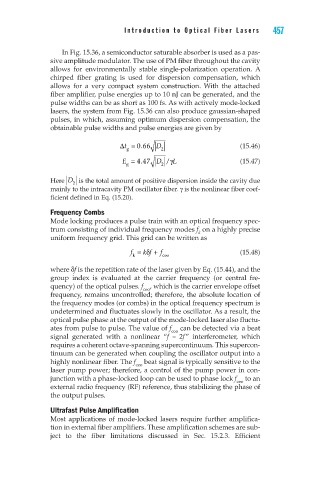Page 489 - High Power Laser Handbook
P. 489
456 Fi b er L a s er s Intr oduction to Optical Fiber Lasers 457
In Fig. 15.36, a semiconductor saturable absorber is used as a pas-
sive amplitude modulator. The use of PM fiber throughout the cavity
allows for environmentally stable single-polarization operation. A
chirped fiber grating is used for dispersion compensation, which
allows for a very compact system construction. With the attached
fiber amplifier, pulse energies up to 10 nJ can be generated, and the
pulse widths can be as short as 100 fs. As with actively mode-locked
lasers, the system from Fig. 15.36 can also produce gaussian-shaped
pulses, in which, assuming optimum dispersion compensation, the
obtainable pulse widths and pulse energies are given by
∆ =t 066 D (15.46)
.
g 2
L
E = 447 D /γ (15.47)
.
g 2
Here D is the total amount of positive dispersion inside the cavity due
2
mainly to the intracavity PM oscillator fiber. γ is the nonlinear fiber coef-
ficient defined in Eq. (15.20).
Frequency Combs
Mode locking produces a pulse train with an optical frequency spec-
trum consisting of individual frequency modes f on a highly precise
k
uniform frequency grid. This grid can be written as
f = k f + δ f (15.48)
k ceo
where δf is the repetition rate of the laser given by Eq. (15.44), and the
group index is evaluated at the carrier frequency (or central fre-
quency) of the optical pulses. f , which is the carrier envelope offset
ceo
frequency, remains uncontrolled; therefore, the absolute location of
the frequency modes (or combs) in the optical frequency spectrum is
undetermined and fluctuates slowly in the oscillator. As a result, the
optical pulse phase at the output of the mode-locked laser also fluctu-
ates from pulse to pulse. The value of f can be detected via a beat
ceo
signal generated with a nonlinear “f – 2f ” interferometer, which
requires a coherent octave-spanning supercontinuum. This supercon-
tinuum can be generated when coupling the oscillator output into a
highly nonlinear fiber. The f beat signal is typically sensitive to the
ceo
laser pump power; therefore, a control of the pump power in con-
junction with a phase-locked loop can be used to phase lock f to an
ceo
external radio frequency (RF) reference, thus stabilizing the phase of
the output pulses.
Ultrafast Pulse Amplification
Most applications of mode-locked lasers require further amplifica-
tion in external fiber amplifiers. These amplification schemes are sub-
ject to the fiber limitations discussed in Sec. 15.2.3. Efficient

